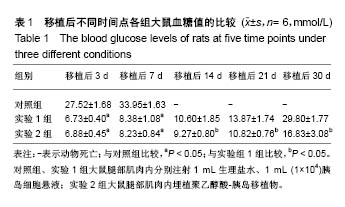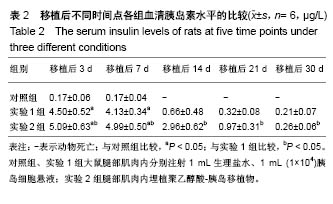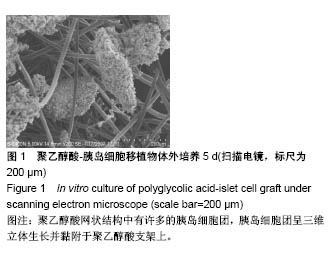| [1] International Diabetes Federation.Diabetes Atlas.7t ed. Brussels:International Diabetes Federation,2015.[2] O'Sullivan ES,Johnson AS,Omer A,et al.Rat islet cell aggregates are superior to islets for transplantation in microcapsules.Diabetologia.2010;53(5):937-945.[3] Beck J,Angus R,Madsen B,et al.Islet encapsulation: strategies to enhance islet cell functions.Tissue Eng. 2007; 13(3):589-599.[4] Emamaullee JA,Shapiro AMJ.Factors Influencing the Loss of β-Cell Mass in Islet Transplantation.Cell Transplant. 2007; 16(1):1-8. [5] 宋今丹,杨恬,李丰.医学细胞生物学[M].北京:人民卫生出版社, 2004.[6] Chun S,Huang Y,Xie WJ,et al.Adhesive growth of pancreatic islet cells on a polyglycolic acid fibrous scaffold.Transplant Proc.2008;40(5):1658-1663.[7] Hou Y,Song C,Xie WJ,et al.Excellent effect of three-dimensional culture condition on pancreatic islets. Diabetes Res Clin Pract.2009;86(1):11-15.[8] 宋纯,黄玉东,侯艳,等.聚乙醇酸生物支架与胰岛的共培养[J].中国组织工程研究与临床康复,2009,13(16):3119-3123.[9] 宋纯,黄玉东,姜再兴,等.PGA细胞支架在大鼠胰岛体外实验中的应用[J].化学与黏合,2009,31(2):28-32.[10] Kandaswamy R,Stock PG,Skeans MA,et al.OPTN/SRTR 2011 Annual Data Report: pancreas.Am J Transplant. 2013; 13 Suppl 1:47-72. [11] 裴广辉,王树森.胰岛移植受者术前评价与管理[J].实用器官移植电子杂志,2016,4(3):177-179.[12] Perez VL,Caicedo A,Berman DM,et al.The anterior chamber of the eye as a clinical transplantation site for the treatment 0f diabetes:a study in a baboon model of diabetes.Diabetologia. 2011;54(5):1121-1126.[13] Rajab A.Islet transplantation:alternative sites.Curr Diab Rep. 2010;10(5):332-337.[14] Salazar-Bafiuelos A,Benitez—Bribiesca L,Sigalet DL,et al. Bone marrow as a site for pancreatic islet transplantation. Blood.2010;115(17):3643-3644.[15] 谢艳,王树森,刘蕾.异种胰岛移植的现状[J].实用器官移植电子杂志,2016,4(6):350-354.[16] 程颖.胰岛分离的研究进展[J].实用器官移植电子杂志, 2016, 4(6):345-349.[17] Rheinheimer J,Bauer AC,Silveiro SP,et al.Human pancreatic islet transplantation:an update and description of the establishment of a pancreatic islet isolation laboratory.Arch Endocrinol Metab.2015;59(2):161-170.[18] Vantyghem MC,Defrance F,Quintin D,et al.Treating diabetes with islet transplantation:lessons from the past decade in Lille. Diabetes Metab.2014;40(2):108-119.[19] Barton FB,Rickels MR,Alejandro R,et al.Improvement in outcomes of clinical islet transplantation:1999-2010.Diabetes Care.2012;35(7):1436-1445.[20] Turgeon NA,Avila JG,Cano JA,et al.Experience with a novel efalizumab-based immunosuppressive regimen to facilitate single donor islet cell transplantation.Am J Transplant. 2010;10(9):2082-2091.[21] Hering BJ,Clarke WR,Bridges ND,et al.Phase 3 Trial of Transplantation of Human Islets in Type 1 Diabetes Complicated by Severe Hypoglycemia.Diabetes Care. 2016;39(7):1230-1240.[22] 王维.异种胰岛移植研究现状和走向临床的关键科学问题[J].器官移植,2017,8(6):413-416.[23] Denner J.Recent progress in xenotransplantation, with emphasis on virological safety.Ann Transplant. 2016;21: 717-727.[24] Bowers DT,Botchwey EA,Brayman KL.Advances in Local Drug Release and Scaffolding Design to Enhance Cell Therapy for Diabetes.Tissue Eng Part B Rev. 2015;21(6): 491-503. [25] Barkai U,Rotem A,de Vos P.Survival of encapsulated islets: More than a membrane story.World J Transplant. 2016;6(1): 69-90. [26] Farney AC,Sutherland DER,Opara EC.Evolution of islet transplantation for the last 30 years. Pancreas. 2016;45(1): 8-20.[27] Mao GH,Chen GA,Bai HY,et al.The reversal of hyperglycaemia in diabetic mice using PLGA scaffolds seeded with islet-like cells derived from human embryonic stem cells.Biomaterials.2009;30(9):1706-1714.[28] Terada S,Yoshimoto H,Fuchs JR,et al.Hydrogel optimization for cultured elastic chondrocytes seeded onto a polyglycolic acid scaffold.J Biomed Mater Res A.2005;75(4):907-916. [29] Kim M,Choi YS,Yang SH,et al.Muscle regeneration by adipose tissue-derived adult stem cells attached to injectable PLGA spheres.Biochem Biophys Res Commun. 2006;348(2): 386-392. [30] Tanaka T,Hirose M Kotobuki N,et al.Bone augmentation by bone marrow mesenchymal stem cells cultured in three-dimensional biodegradable polymer scaffolds.J Biomed Mater Res A.2009;91(2):428-435.[31] Lu HH,Kofron MD,El-Amin SF,Attawia MA,et al.In vitro bone formation using muscle-derived cells: a new paradigm for bone tissue engineering using polymer-bone morphogenetic protein matrices.Biochem Biophys Res Commun. 2003; 305(4):882-889.[32] Ishaug-Riley SL,Crane-Kruger GM,Yaszemski MJ,et al.Three-dimensional culture of rat calvarial osteoblasts in porous biodegradable polymers.Biomaterials. 1998;19(15): 1405-1412. [33] Yang EY,Kronenfeld JP,Stabler CL.Engineering biomimetic materials for islet transplantation.Curr Diabetes Rev. 2015; 11(3):163-169. [34] Lesman A,Koffler J,Atlas R,et al.Engineering vessel-like networks within multicellular ? brin-based constructs. Biomaterials.2011;32(31):7856-7869.[35] Lee SJ,Lim GJ,Lee JW,et al.In vitro evaluation of a poly(lactide-co-glycolide)-collagen composite scaffold for bone regeneration.Biomaterials.2006;27(18):3466-3472.[36] Young CS,Abukawa H,Asrican R,et al.Tissue-engineered hybrid tooth and bone.Tissue Eng. 2005;11(9-10):1599-1610.[37] Hu X,Lui W,Cui L,et al.Tissue engineering of nearly transparent corneal stroma.Tissue Eng. 2005;11(11-12): 1710-1717.[38] Lu HH,Cooper JA Jr,Manuel S,et al.Anterior cruciate ligament regeneration using braided biodegradable scaffolds: in vitro optimization studies.Biomaterials.2005;26(23):4805-4816.[39] McBane JE,Battiston KG,Wadhwani A,et al.The effect of degradable polymer surfaces on co-cultures of monocytes and smooth muscle cells.Biomaterials. 2011;32(14): 3584-3595.[40] Xue Y,Danmark S,Xing Z,et al.Growth and differentiation of bone marrow stromal cells on biodegradable polymer scaffolds: An in vitro study.J Biomed Mater Res A. 2010;95(4): 1244-1251.[41] Smink AM,de Haan BJ,Paredes-Juarez GA,et al.Selection of polymers for application in scaffolds applicable for human pancreatic islet transplantation.Biomed Mater. 2016;11(3) 035006.[42] Lynne PR,Bilinski SA,Malgorzata K,et al.Microgravity culture condition reduces immunogenicity and improves function of pancreatic islets.Transplantation.2002;74(1):13-21. |
.jpg)




.jpg)